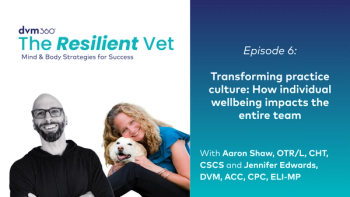
The power of trauma-informed care
With a little work and a lot of commitment, could the vision of trauma-informed care and leadership from the human medical world transform your veterinary hospital for the better?
isavira/stock.adobe.com
More on trauma and stress
Dr. Dogan recently helped us deliver an entire package of content about compassion fatigue, secondary stress and more in the veterinary workplace. You can find:
•
•
•
•
•
•
I first heard of trauma-informed care and trauma-informed leadership at the
Early thinkers on the topic developed five principles fundamental to creating and sustaining trauma-informed settings.3 Each is vital to accommodating the vulnerabilities and needs of trauma survivors and to facilitating their participation in treatment. These principles are:
• Ensuring safety
• Establishing trustworthiness
• Maximizing choice
• Maximizing collaboration
• Prioritizing empowerment.
At the Boston conference, there was discussion about applying this approach to educational systems in America today, but I spent the time thinking about what it would look like to apply these five principles to veterinary medicine. I'm not advocating for treating coworkers and clients with trauma in ours practices-that's not our job. What is our job in any setting, as fellow humans to each other, is to try and understand what an individual may be going through and being supportive (just providing support can help in instances of severe traumatic stress on the job).
Turning a veterinary practice and its leaders into a trauma-informed workplace
What does a trauma-informed organization (or veterinary hospital) look like? According to the Substance Abuse and Mental Health Services Administration (SAMHSA), those in the workplace:
• Realize the widespread impact of trauma and understand potential paths for recovery
• Recognize the signs and symptoms of trauma in clients, staff and others involved
• Respond by fully integrating knowledge about trauma into policies, procedures and practices
• Seek to actively resist retraumatizing those involved.
When emotional responses are triggered in the workplace, each person responds according to the extent of their emotional traumas and emotional strengths. Some appear stoic and detached from emotions during conflict, which can be a helpful defense for them. Others may become emotionally flooded and have difficulty negotiating their thoughts and feelings well (as outlined in
Now, you might be thinking, this sounds great but where do you start and how do you implement this? Unfortunately, it's a bit like when
Somewhere to start
Here are some guidelines as outlined by the
Purpose of the guidelines. As with the standards of practice in any field, the practitioner is required to abide by standards of self-care. These guidelines are used by all members of the Green Cross. The purpose of the guidelines is twofold:
• First, do no harm to yourself in the line of duty when helping/treating others.
• Second, attend to your physical, social, emotional and spiritual needs as a way of ensuring high-quality services to those who look to you for support as a human being.
Ethical principles of self-care in practice. These principles declare that it is unethical not to attend to your self-care as a practitioner, because insufficient self-care can lead to harming those we serve.
• Respect for the dignity and worth of self: A violation lowers your integrity and trust.
• Responsibility of self-care: Ultimately, it is your responsibility to take care of yourself, and no situation or person can justify neglecting it.
• Self-care and duty to perform: There must be a recognition that the duty to perform as a helper cannot be fulfilled if there is not, at the same time, a duty to self-care.
Standards of humane practice of self-care
• Universal right to wellness: Every helper, regardless of her or his role or employer, has a right to wellness associated with self-care.
• Physical rest and nourishment: Every helper deserves restful sleep and physical separation from work that sustains them in their work role.
• Emotional rest and nourishment: Every helper deserves emotional and spiritual renewal both at and outside of work.
• Sustenance modulation: Every helper must use self-restraint with regard to what and how much they consume (e.g., food, drink, drugs, stimulation), because it can compromise their competence as a helper.
Standards for expecting appreciation and compensation
• Seek, find and remember appreciation from supervisors and clients: These and other activities increase worker satisfaction to sustain them emotionally and spiritually in their helping.
• Make it known that you wish to be recognized for your service: Recognition increases the worker satisfaction that sustains them.
• Select one or more advocates: These are colleagues who know you as a person and a helper and are committed to monitoring your efforts at self-care.
A commitment to self-care
• Make a formal, tangible commitment-a written, public, specific and measurable promise of self-care
• Set deadlines and goals-self-care plans need to be connected to specific activities of self-care
• Generate strategies that work and follow them-an attainable plan with commitment and monitored by advocates of your self-care
You can bring positive change to your veterinary hospital, and it can start with baby steps that will eventually pave the way to bigger and better things. Start with yourself, others will follow.
References
1. Harris M, Fallot RD (Eds.). Using trauma theory to design service systems. San Francisco, CA: Jossey-Bass, 2001.
2. Butler LD, Critelli FM, Rinfrette ES. Trauma-informed care and mental health. Directions in Psychiatry 2011;31:197–210.
3. Trauma Informed Oregon. Creating cultures of trauma-informed care (CCTIC): A self-assessment and planning protocol. Available at:
Frequent
Newsletter
From exam room tips to practice management insights, get trusted veterinary news delivered straight to your inbox—subscribe to dvm360.




